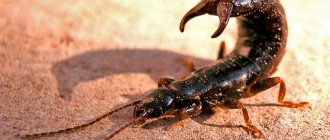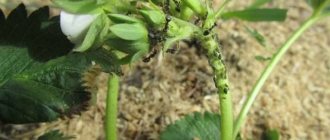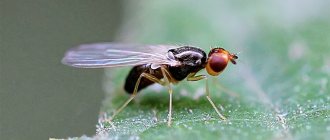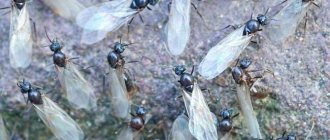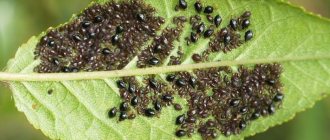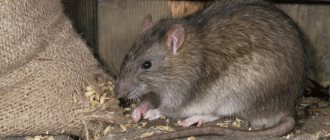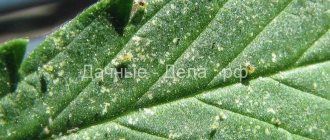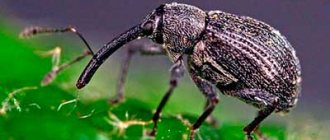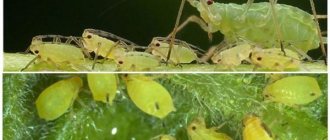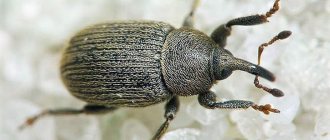Let's start with the fact that a massive invasion of the cockchafer can occur no more often than in 4-5 years. In other years, it behaves quite peacefully and hardly harms our plantings, so we even forget how to deal with beetleworm on strawberries.
The fact is that the development cycle of this insect is such that in the larval stage it develops for quite a long time, from two to three years, and after hatching, it dies soon after mating. That’s why its invasions of gardens are so cyclical.
Signs of strawberry damage
May beetle larvae parasitize throughout the warm season. A sign of a pest on strawberries is:
- growth slowdown;
- lack of flowers, berries;
- withered leaves;
- blackened stems.
When a site is massively infected, almost all bushes become damaged. Strawberry yields decrease and plants die.
You can find the beetle larva when digging up the soil in the garden bed - in the rows, around the plant. There is also one of the most effective methods to detect the parasite immediately. Water the strawberry bush, carefully dig it up, carefully examine the roots and the soil in the hole. The larva of the cockchafer is white and large, so it is easy to distinguish it from other strawberry pests.
Folk remedy for cockchafer larvae on strawberries
If you don’t want to use chemicals, you can try traditional recipes. The effectiveness of such drugs largely depends on the contamination of the soil, as well as regular use.
- Spray the plantings with a weak solution of ammonia (5 drops per 10 liters of water) in early spring.
- Place cabbage leaves between the rows and plant radishes.
- Acidification of the soil with nitrogen fertilizers also makes the environment unsuitable for pests.
- An infusion of onion skins or garlic can repel adults. To do this, the plantings are sprayed in advance, before the start of the mating season.
Additional control methods:
- Ammonia. Ammonia from cockchafer larvae helps get rid of pests at any stage of development. The pungent smell repels, and the composition of the soil also changes - a large amount of nitrogen is not to the liking of pests. Add 1/3 of a standard bottle to a bucket of water. Water the row spacing and strawberry bushes. The method can be used no more than 2 times a month.
- Clover. It saturates the soil with ammonia, inhibits the growth of weeds, and is itself unpalatable to beetle larvae. Planted between rows, around the bed.
- Garlic. Fill the cloves or arrows with cold water and leave for three days. Water the strawberries generously. Several such procedures, the larvae will leave the area.
Preventive actions
Well, in order to minimize the number of pests on your site, you need to try to create conditions for them in which they would not be comfortable.
It is known that soil with a large amount of nitrogen is not suitable for the development of larvae. Therefore, in the fall, nitrogen fertilizers need to be applied before digging. Some sources advise drenching the soil with chlorine solution and applying chlorine-containing fertilizers. But the dose of chlorine, destructive for the larvae, is too high for cultivated plants. To increase the amount of nitrogen in the soil, tree trunks and beds with berry bushes are sown with green manure (for example, lupine or clover).
Since wheatgrass roots attract larvae, it is imperative to destroy this malicious weed. Moreover, when digging, remove roots not only in the beds, but also in the aisles. This is where a large number of them usually accumulate.
The beds should be mulched with straw, shavings or cut green manure. These materials prevent female beetles from entering the soil.
If this does not help, make grooves around the beds to a depth of 40 cm and pour a 75% karbofos solution into them.
In an area with a large number of beetles, it is recommended to create a protective barrier around the seedlings. To do this, you can use plastic bottles without a bottom. They are buried to a depth of 20-30 cm, and then plants are planted in the resulting container.
Due to the fact that Khrushchev is widespread, the fight against it can be long and grueling. But for those who love their garden, nothing is impossible!
How to water strawberries against cockchafer larvae
Specialized preparations have the best effect for combating the cockchafer caterpillar in the garden. They have a nerve-paralyzing effect on the body of insects, therefore they are effective against other agricultural pests.
The remedy for cockchafer larvae can be bought in a specialized store, in the market in hardware departments, or you can order it online. You can protect strawberries during planting, during the period of active growth.
The most popular means:
- "Antikhrushch" is diluted according to the instructions, 100 ml per 10 liters. water. The solution is poured under each bush at the rate of 30-50 ml. The effect lasts up to 45 days, but for early ripening crops, a similar drug is used only after harvesting.
- "Aktara" also has a long-lasting effect (from 40 to 100 days), so it is used in mid-summer. Not suitable for remontant varieties of strawberries or raspberries. The method of application includes treating the roots of plants before planting, as well as spilling the soil.
- "Karbofos" is usually used to process potatoes. The validity period of the drug allows it to be used during planting (not for early varieties), and it provides a complex effect against different types of garden parasites.
- Bazudin. Used for spring planting. Apply to the soil. Retains properties for 6 weeks. Refers to non-systemic organophosphorus insecticides. The cost of a 12.5 ml bottle is about 150 rubles.
- Force. The granular preparation is applied to the soil during digging and loosening. Consumption 12 kg per 1 hectare of land. Used a week before planting the crop. The price of the package is about 600 rubles.
It is prohibited to use toxic substances during the period of active flowering and ripening. During this period, folk remedies and physical methods of struggle are used.
Bacteriological preparations are popular. Insecticides such as “Nemabakt” or “Antonem-F” contain nematode bacteria that settle in the body of the worm and lead to its death. They are not dangerous for plants, animals or humans; use is carried out according to the instructions for the specific drug.
How to clean strawberries from bugs
The methods developed to combat the cockchafer are varied. Conventionally, they can be divided into mechanical, biological and chemical, depending on the means used.
Catching adult individuals is usually less labor-intensive, but fighting the larvae is much more difficult and time-consuming. Various methods are used for this, but the best results will come from an integrated approach and the involvement of neighbors.
Catching
The easiest way to destroy the cockchafer on strawberries is to collect adult individuals and regularly dig up the soil. This way you can prevent further contamination of the soil, but it is necessary to act systematically, involving the owners of adjacent plots in the fight.
Homemade traps
The mechanical collection of specimens can be improved and facilitated by using homemade traps. To do this, it is necessary to provide an environment that is attractive from the point of view of insects, for example, a compost pit. Containers with “bait” are regularly inspected, and any found specimens are destroyed.
You can make glue baits yourself, and also scatter potato tubers treated with insecticide around the garden. Light traps work well, but it is impossible to completely get rid of pests using such methods.
Natural enemies
You can entrust the collection to professionals - to attract natural enemies to the site: starlings, rooks and other birds. Despite its effectiveness, this method is fraught with unpleasant consequences - damage to the harvest of fruit trees, because many birds are not averse to profiting from ripe berries and fruits.
Hedgehogs also love to eat garden pests. In their summer cottages, many gardeners specifically recruit these helpers.
Green manure
If possible, systematic destruction can be carried out in a completely safe way. To do this, the area is well dug up and planted with lupine for the season. In addition to the fact that such a step is extremely beneficial for the soil (lupine is a green manure plant), its roots contain compounds that are poisonous to the larvae. You should know that the fight against them must be carried out regularly, because the population is rapidly increasing.
Traps
An effective way to combat pest larvae is to catch adult chafers.
Traps for May beetle
Since one female lays several hundred eggs, a method such as a trap is very rational and effective. Procedure:
- Prepare a deep container, lubricate its inside with a sticky substance, for example, grease.
- Place a light source at the bottom of the container and wait until evening.
- Then place the light trap in an open area of the garden so that the pest can see it from afar.
- The cockchafer will fly inside and stick its paws to the sticky substance.
May beetle larva eats strawberries - what to do
Aktara, Decis, Karbofos, Zolon, Marshall, Bazudin give a good effect.
Khrushchev larvae most often cause damage specifically in strawberry plantings. The vegetation cycle of this plant is approximately 4-5 years, during which the soil is not completely dug up, so the risk of pests is very high. Voracious worms destroy plantings very quickly.
The main sign of damage is the death of several plants for no apparent reason. The bushes begin to wither and dry out, and when digging, you can discover the absence or damage of the roots, or the culprit itself - a large white larva of a curved shape.
To prevent damage to the crop, you can use the following recipes:
- Plant plants that repel cockchafers between the rows. These are fragrant marigolds, white clover, cabbage, radishes (radishes) or onions.
- Mulching the soil in the beds repels females, preventing them from laying eggs. For this, sawdust from coniferous trees, straw or dry pine needles are used.
- Periodically, plantings can be sprayed with a weak solution of potassium permanganate, as well as an infusion of onion peels.
- Change the planting site when updating the crop. It is better to allocate a different place for strawberries each time, carefully digging and treating the planting site with insecticides. Until the period of fruiting of young plants, there will be no trace of chemical compounds left, and the soil will be disinfected from larvae and eggs for at least a year.
- Prepared solutions of insecticides can be spilled between the rows, providing protection from pests, and folk recipes can be used directly on the beds themselves.
When planning to transplant bushes, be sure to check the soil; usually the larvae are located at a depth of 30-40 cm from the surface. Digging allows you to get rid of the bulk of the larvae, and the methodical destruction of adult beetles in the spring prevents the appearance of new insects.
How to protect
To protect strawberries from larvae:
- Combine annual digging of the soil with the selection of larvae.
- Plant beetle repellent plants between the rows.
- Pour a little dry mustard into each well.
- Plant green manure plants in the garden beds in the fall.
- Use chemicals for severe lesions.
The fight against cockchafers must be carried out methodically, using all possible methods. You should not assume that the absence of larvae last year will protect the crop for a long time, because new pests will not keep you waiting.
In addition to the beetleworm, strawberries are affected by other pests: weevils, aphids, strawberry mites, whiteflies, leaf beetles, and slugs.
Physical methods
Take an integrated approach. The fight against the cockchafer and its larvae is carried out using the following methods:
Light and sticky traps - if there are offspring of the cockchafer in the garden, then perhaps there are adults nearby
It is important to build special baits: prepare the dishes in advance, coat the inside with glue or other sticky substance, place a light bulb at the bottom, place the trap so that it can be seen from afar. When it gets dark, the insects will come to light: this way you can catch not only beetles, but also caterpillars and cutworm butterflies
Additionally or as an alternative to this method, use paper strips coated with adhesive. Shaking the bushes. Every morning, shake off the beetles sitting on the strawberries and collect them with your hands: this way the females will not have time to lay eggs. In May, strawberry leaves are half-bloomed, so the beetle will be clearly visible. Deep digging of the site in late autumn. Before the procedure, add dry bleach to the soil. Additionally, prepare warm places for the larvae: dig holes, fill them with half-rotted manure or compost. When frost sets in, scatter the contents of the traps: the larvae on the surface of the ground will quickly die from the low temperature. Digging up beds in the spring, when the larvae are located in the upper layers of the soil. Work with damp soil, otherwise pests can burrow to a depth of 60-70 cm. Timely get rid of weeds in the area, especially wheatgrass. Remember that grass is a delicacy for beetles.
Prevention
It is impossible to completely protect your garden, but everyone can reduce the risk of voracious pests. To do this, it is necessary to use an integrated approach: fight with mechanical or chemical methods, use folk remedies.
For prevention purposes, it is necessary to regularly dig up the soil and treat it with disinfectant solutions. A big plus is that such methods allow you to simultaneously get rid of other garden pests and reduce the risk of fruit damage.
Adviсe:
- In the spring, when beetles are active, it is necessary to regularly collect beetles from trees, use light traps, and attract natural enemies.
- Plants with a strong odor (onions, garlic, marigolds, clover) can be used as a deterrent. Rows with these crops are placed between plantings. May beetles also do not like members of the cruciferous family (cabbage, radishes, radishes).
- In case of severe infestations, it is more advisable to choose a chemical or bacteriological insecticide and use green manure plants.
- During the flight of beetles, traps are set for them - bottles with sweet water. This prevents the appearance of new larvae in the soil.
- Beans, clover, and beans are sown on plantations. Urea and ammonium nitrate are added to enrich the soil with nitrogen, which the larvae cannot tolerate.
- Parasites are collected by hand by digging up wilted bushes and examining the lump of earth on the roots.
- Water the beds abundantly - the larvae do not like wet soil.
Water the plants using folk remedies:
- onion infusion: 100 g of onion peel is poured into a bucket of warm water, left for 3-5 days;
- iodine solution: 10–15 drops of iodine are diluted in 10 liters of liquid.
The following chemicals are used for root irrigation (more convenient with drip irrigation):
- Aktaru (1.4 ml / 0.7 l of water) – after harvesting;
- Antikhrushch (100 ml / bucket of liquid) – after picking the berries.
The appearance of a cockchafer on strawberries is an alarming sign for any gardener. Voracious pests are capable of destroying plantings, so various methods are used to destroy these insects. An overview of the best ways to deal with them is given in our information.
"Folk" methods of protection
It is possible to get rid of the cockchafer using “folk” techniques:
a) The easiest way is to collect beetles by hand. By either shaking them off the trees in the mornings and evenings. Or you can hang a white cloth in the garden and illuminate it; the beetles react to this trap and gather in the grass. Detected beetles are collected and destroyed;
b) You can install birdhouses and feeders to further attract birds to your suburban area;
c) Set traps - use a flat container (basin), put bait there, and coat the edges with sticky glue, i.e. make so-called “catching belts”;
d) Use “ammonia water”. The working solution is prepared from ammonium nitrate 0.2 kg/10 l. water. And the beds are watered 2 months before planting, then they are dug up.
e) Water the beds against soil pests with a solution using ammonia (0.5-1 tbsp/10 l of water);
f) Potassium permanganate is used in the same way. And some gardeners use chlorine solutions or bleach when digging in spring (I don’t think this is the right approach);
g) Planting garlic along the edges of the bed and many many others.
“Folk” ways to get rid of the cockchafer are of questionable effectiveness, but they also have their place. To ensure maximum effect, they are best used in conjunction with chemical and biological methods of protection against soil pests.
Detailed description of the pest
The May beetle belongs to the order of Coleoptera lamelatiidae. Sometimes the insect is called Khrushchev because it belongs to the Khrushchi family. Beetle larvae in Ukraine are called chrobaks.
These powerful beetles can be more than 30 mm long. The head is decorated with a pair of plate-shaped horns. When magnified many times, the beetle looks quite menacing. The body is covered with hard brown or streaked brown elytra. Below them is a powerful wing. These beetles can fly quickly and for a long time.
Adult beetles feed on the foliage of trees and shrubs, buds, and fruit ovaries. They do not cause much damage to the crop.
May beetle larvae bother gardeners. The female is capable of laying about a hundred eggs per season. From them, larvae (furrows) similar to large caterpillars will develop within 3-4 years.
The larva has a pale yellow color, a semi-circular body with three pairs of legs. In the ground, it goes through its development cycle for 4 years.
Nutrition
The cockchafer's diet is exclusively plant-based. If adult insects eat the leaves of trees, shrubs and herbaceous plants, in general, not presenting a big problem for owners of summer cottages, then the larvae are a real scourge for agriculture. The fact is that they live under the soil layer and feed on plant roots there.
Despite the fact that strawberries are not among their preferences, it is damage to the roots of this plant that brings the most grief to our gardeners.
Reproduction and lifestyle
May beetles appear, as their name suggests, in May, at which time the leaves on the birch tree are just beginning to bloom, which these pests happily snack on.
At the same time, the beetles fly – the process of their reproduction. Soon after mating, females lay extensive ovipositions in the soil, sometimes containing up to seventy eggs. Soon after this, adult insects, having completed their assigned mission, die.
The eggs soon, from 15 to 30 days depending on the soil temperature, hatch into larvae, which in the first year look like tiny maggots. They do not cause any harm, since they feed mainly on plant debris.
Having overwintered at depth, very often under a manure or compost heap, in the second year their rapid growth and development begins, after which in the third year of their life they pupate and an adult appears. If the year is unfavorable for development, the larva may not pupate, but may survive in this phase for another summer season.
The larvae of the cockchafer of the second and third years of life on strawberries pose the greatest danger. They develop rapidly, consuming large amounts of food, most often the roots of various plants. Moreover, the more tender and fluffy the roots, the more willingly the beetle larvae attack them.
The life cycle of this pest is quite long; from the moment the eggs are laid, two to three years pass until the formation of an adult. At the same time, beetles pose a danger to cultivated plants at every stage of their existence.
Let's use force
Enzyme traps will be most effective if your neighbors also hang them.
The use of light traps, morning shaking of insects from flowering trees and bushes, removal of larvae by digging, all this takes place, but it is very difficult to significantly reduce the pest population alone.
Heaps of manure laid out on the site work well as bait. The female lays eggs in them, and when the manure rots, it forms humus and “feeds” the larvae, which become clearly visible for collection. When cleaning the heap, you can invite chickens to help - they will not leave a chance to any pest.
Damage from insects
If you find this insect on your site, it is imperative to fight them. Typically, contaminated soil is found on abandoned, rarely dug up lands. That is why it is necessary to carefully cultivate the soil before planting.
It is especially important to take timely measures to combat the larvae of the cockchafer in strawberries, because even with a small population, plantings can quickly die.
Main harm:
- Adults eat flowers and ovaries, young leaves.
- The larvae completely destroy the root system and tubers of plants.
It is impossible to grow a good crop in an infected area. Before planting, you should carry out a simple test: dig up a square meter of soil. If 1-2 larvae are detected, the soil is suitable for growing garden crops. If the number of pests is greater, it is imperative to carry out preventive treatment, for which traditional methods and special chemicals are used.
